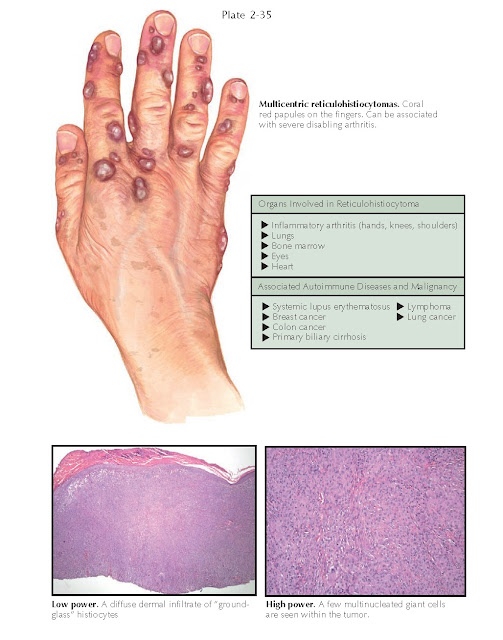RETICULOHISTIOCYTOMA
Reticulohistiocytomas,
also called solitary epithelioid histiocytomas, are conglomerations of large
eosinophilic histiocytes within the dermis. The cytoplasm of these cells has
been described as “glassy” in appearance. Reticulohistiocytomas are a subset of
the histiocytoses group of diseases. In contrast to the other histiocytoses,
patients with reticulohistiocytoma have normal lipid levels.
Reticulohistiocytomas can occur as a
solitary growth or as multiple growths in a condition known as multi-centric
reticulohistiocytosis. The solitary variant is more often seen. On
histopathological examination, the two clinical variants are identical in
nature. Multicentric reticulohistiocytosis is a rare disease with systemic
involvement. It can often be a marker of internal malignancy, and patients are
afflicted with a severe arthritis.
Clinical Findings: Solitary lesions are typically small, firm dermal
nodules ranging from 1 to 2 cm in diameter. They are usually asymptomatic.
Their coloration may vary, but most often they are slightly pink to red-brown.
They are found most commonly on the head and neck region of the body but have
been described in all locations. They occur with similar frequency in males and
females and have no age or race predilection.
Multicentric reticulohistiocytosis is
unique in that it occurs in an older population, with a higher percentage of
females affected. The number of lesions is in the hundreds to thousands. The
multiple reticulohistiocytomas found in this condition are most often
localized to the dorsal aspect of the hands and to the face. A distinctive
finding is that of small papules along the lateral and proximal nail folds.
This finding has been described as “coral beading,” and it is highly specific
for multicentric reticulohistiocytosis. These patients also have a severe
arthropathy, and this diag- nosis should lead one to look for an underlying
malignancy. The arthropathy almost always affects the interphalangeal joints,
particularly the distal interphalangeal joints. Multicentric
reticulohistiocytosis is believed to be a paraneoplastic condition in up to 25%
of the cases. The type of malignancy is variable, with no predominant type more
prevalent than any other. For this reason, age-appropriate cancer screening is
recommended. In about one third of patients with multicentric
reticulohistiocytosis, the joint symptoms precede the growths; in one third,
they appear at the same time; and one third of the patients develop only clinically
minor or no arthropathy. This arthropathy is a severe inflammatory arthropathy
that is symmetric and polyarticular. A mutilating arthritis may develop,
sometimes very quickly. Early recognition and treat- ment has helped decrease
the progression into severe mutilating arthritis. This truly is a multisystem
organ disease. Many patients have cardiac involvement, and almost all organ
systems have been reported to be affected, some with fatal outcomes.
Pathogenesis: Multicentric reticulohistiocytosis and solitary
reticulohistiocytoma are believed to represent a rare disorder of histiocytes.
The cause of the histiocytic proliferation is unknown.
Histology: The tumor shows a well-circumscribed dermal
infiltrate without a capsule. The infiltrate is made up almost entirely of
histiocytes with a “ground-glass” appearance of the cytoplasm. Multinucleate
giant cells are always seen. They contain more than three nuclei, which can be
arranged in many variations. The cells stain with the immunohistochemical
stains CD45 and CD68, but do not stain with S100. On electron microscopy, no
Langerhans cells are found in the infiltrate.
Treatment: Solitary reticulohistiocytomas are cured with a
simple elliptical excision. They rarely recur. Patients with multicentric
reticulohistiocytosis require systemic therapy. Screening and constant
vigilance for an underlying malignancy is required in all cases.
Corticosteroids, methotrexate, hydroxychloroquine, and cyclophosphamide have
all been used. Anti–tumor necrosis factor (anti-TNF) agents have been used. The
goals are to prevent or suppress the arthropathy and to screen for malignancy.





